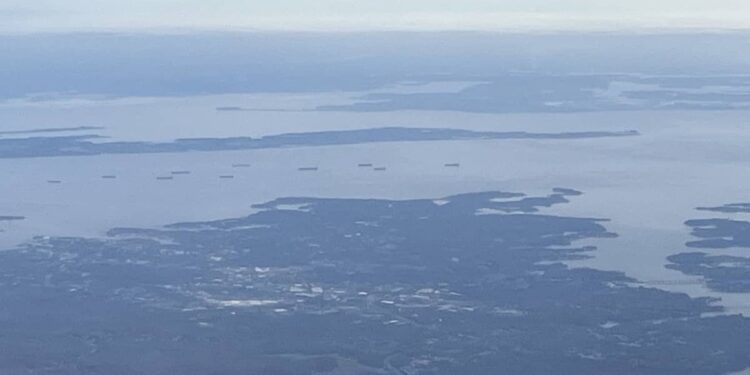The American port of Baltimore, a nerve center for international maritime trade, was at a standstill on Tuesday after the collapse of the Francis Scott Key bridge, hit by a container ship.
• Read also: Bridge collapse in Baltimore: the effect of “a big thunderclap”, according to a resident
• Read also: Bridge collapse in Baltimore: pilots have nothing to blame
• Read also: Baltimore bridge collapse: ‘it’s like science fiction’
This bridge, named after the poet who wrote the words to the American national anthem, collapsed in the middle of the night, immediately after being hit by a ship.
President Joe Biden said he “intends that the federal government will pay the entire cost of reconstruction” of the structure located in the state of Maryland, in the northeast of the country, on which 34,000 vehicles travel every day .
AFP
“And I hope that Congress will support my efforts,” he said Tuesday during a speech from the White House, warning that “it will take time.”
This bridge is “essential for travel, not only for Baltimore, but also for the entire northeast corridor” of the country, commented the American president.
It is, according to the Maryland Chamber of Commerce, “a critical transportation artery” for the state. “Its prolonged closure will inevitably disrupt commercial activities and supply chains,” the Chamber of Commerce said.
Shipping to and from the Port of Baltimore has been suspended until further notice, potentially causing significant economic damage.
AFP
“The Port of Baltimore is one of the largest maritime hubs in the country,” Joe Biden further emphasized, promising to “put it back into service as soon as possible.”
He announced that the Army Corps of Engineers was “on site” to help “clear the way” on the Patapsco River, an arm of the Chesapeake Bay, which connects Baltimore to the Atlantic Ocean.
Baltimore is a major arrival or departure point for container ships. In 2023, 1.1 million containers, or, in maritime transport jargon, TEUs (twenty-foot equivalent units, the sector’s reference unit), were loaded and unloaded there.
“With the expansion of the Panama Canal in 2016, to allow larger ships to pass through”, these gigantic boats loaded with goods can directly, from Asia, reach the Atlantic coast, details the website of the State of Maryland.
New cars exported and imported
The port of Baltimore, created in the 17th century to export tobacco to England, was in 2023 the gateway to the United States for more than 52 million tons of foreign goods, worth more than 80 billion dollars, according to a recent statement from state Governor Wes Moore.
Baltimore has been, for 13 years, the American port through which the most new cars pass, more than 800,000 last year. Whether they are vehicles manufactured in the United States and exported internationally, or, conversely, foreign vehicles imported into the United States.
AFP
This is also where most imports of sugar and gypsum – a mineral used to make plaster – arrive and where a significant quantity of American coal sold internationally leaves.
It now ranks ninth among U.S. ports in terms of foreign cargo handled and value of foreign cargo.
The goods, once unloaded in Baltimore, are then only one night by train or truck from a third of the American population.
Several cruise lines also offer departures from Baltimore, or stop there.
Getty Images via AFP
Thus, more than 15,000 jobs directly depend on the Port of Baltimore, and, indirectly, nearly 140,000 additional jobs.
Large bridges over shipping lanes like this are supposed to be designed to minimize damage in the event of a collision, according to engineer and bridge designer Robert Benaim of the Royal Academy of Engineering.
“It is clear that the protection of the pillars in this case was inadequate,” he added.
“It is obvious that the pillar could not withstand the energy of the impact,” said Toby Mottram, professor of structural engineering at the University of Warwick, who judges that “the extent of the damage caused to the bridge superstructure appears disproportionate to the cause.



